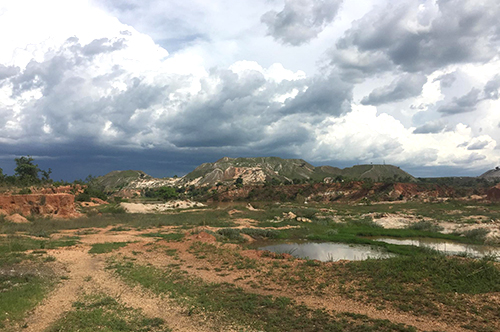Manono is finding a new life as a mining town after years of neglect.
By Graeme Johnston, Project Manager, AVZ Minerals – Manono

When touching down on Manono’s dusty airstrip, a leisurely 90 minute flight north of the DRC’s second largest city Lubumbashi (a hove of frenetic copper and cobalt exploration activity at the moment) you might be forgiven for thinking that you had arrived in the land that time forgot. Driving out of the airport, past the UN camp and into the main part of Manono can be unnerving to those like myself who have not spent much time in the centre of Africa. However, the incongruities of driving past various international aid outlets and NGO compounds into the wide, old fashioned Belgian mango tree lined boulevards with their elegant, but sadly, run down houses only serves to highlight the long history of colonial involvement in the country and its more recent turbulent past.
Logistically the town of 30,000 plus souls seems to be completely isolated from the metropolis of Lubumbashi and indeed the dilapidated road to the provincial capital does nothing to dispel that idea. However, positive vibes coming from not only the AVZ’s current exploration activities, as well as the recent signing of an agreement to start rebuilding the main road to Lubumbashi commencing this April, add to the air of excitement seeping through the old town. Exploration and mining is back on the agenda.
Exploring an old tin and coltan mine that operated from 1919 to 1980 has been a fascinating experience. The original operators used a simple free dig, truck and washing process, utilizing only the most weathered parts of the pegmatite. Here the feldspar, that is one of the three main minerals that make up the orebody, with quartz and spodumene being the other two, weathered down to a potassium rich clay. This led to the disintegration of the rock allowing it to be picked up using steam driven excavators (their remnants are still visible today) and trucked to any of the four washing plants situated evenly along the eastern edge of the orebodies. Here it was washed, mostly without any crushing, and the heavy tin and coltan collected using gravity separation. The concentrate was transported to the Congo river by barges from the site along the Likushi river which was dammed in the middle of the orebody to provide process water for the washing plants. After the soft material was used up, a previous mine operator tried to crush the low grade tin ore and, when this was found to be uneconomic due to increased mining costs, the mine closed.
This simple observation of rock strength to weathering of the pegmatite, and hence the level of surface leaching of the lithium in the spodumene, has been proven by surface sampling and has assisted greatly in the planning for the upcoming JORC compliant exploration program currently underway. Surface sampling and mapping confirm that the harder, unmined areas contain fresher ore grade spodumene.
The Roche Dure prospect in the Southern Kitotolo sector was drilled by the Belgian operators of the mine to depths of only up to 40 metres deep into the shallowly dipping pegmatite orebody. Below this the pegmatite was too fresh and hard to supply their mining fleet with the free digging material required. In essence, there was no deep drilling up until 2017, which makes it an incredibly rare beast geologically speaking – a world class undrilled lithium pegmatite orebody which was extensively surface mined without the true value of the ore being recognized.
With continual increases in the demand for lithium products and battery additives in general there is no doubt that Manono will again reassert itself as a dominant mining town in a region well known for its tin and tantalum resources. Local government officials have noted the increased activity and support at all levels, both provincial and federal, has been offered to assist the new exploration activities currently underway. The development of “new” minerals like lithium and cobalt will underpin a new round of investment into the DRC and specifically the Tanganyika province. As the first major lithium project in the DRC, the country will watch with interest to see what the old town can produce in this second mining reincarnation for Manono.
After this tour of the Manono township, the old colonial era tin mine and the excitement of the race to be the first major lithium producer in the DRC, it is hard not to reflect that there is indeed life in the old place after all and a strong and exciting future ahead.
